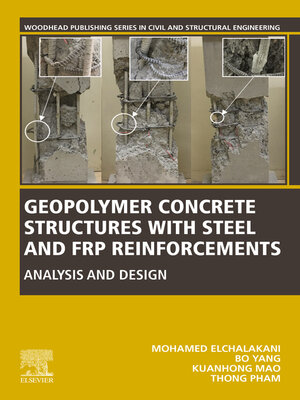Geopolymer Concrete Structures with Steel and FRP Reinforcements
ebook ∣ Analysis and Design · Woodhead Publishing Series in Civil and Structural Engineering
By Mohamed Elchalakani

Sign up to save your library
With an OverDrive account, you can save your favorite libraries for at-a-glance information about availability. Find out more about OverDrive accounts.
Find this title in Libby, the library reading app by OverDrive.



Search for a digital library with this title
Title found at these libraries:
| Library Name | Distance |
|---|---|
| Loading... |
Geopolymer Concrete Structures with Steel and FRP Reinforcements: Analysis and Design focuses on structural behavior, including the aspects of compression, bending strength and combined action of GPC members, with the book's content based on published studies over the last two decades. Geopolymer concrete (GPC) structural members reinforced with FRP reinforcement have some advantages in resisting forces compared to conventional concrete or steel tubular members. Among the most important are the high strength and bending stiffness, fire and impact performance and favorable, construction ability and durability.
To this end, there are no significant applications of these new structural elements worldwide, partly due to the lack of the understanding of their behavior and insufficient design provisions in different design manuals. This book, therefore, seeks to highlight their characteristics and future potential. - Provides comprehensive, up-to-date advances on Geopolymer Concrete (GPC) reinforced with steel and FRP bars and stirrups construction with a summary of over 100 papers published in the last decade
- Compares the behavior and failure modes between Geopolymer Concrete (GPC) structures and Ordinary Portland Concrete (OPC) structures
- Explains important concepts such as bond, confinement, fracture of stirrups and buckling of FRP bars
- Includes an in-depth analysis of ultimate strength of GPC and OPC, considering governing failure modes
- Presents design examples following international standards, including North America ACI 440.1R-15, Canadian CAN/CSA S806, and Australian such as AS 3600







